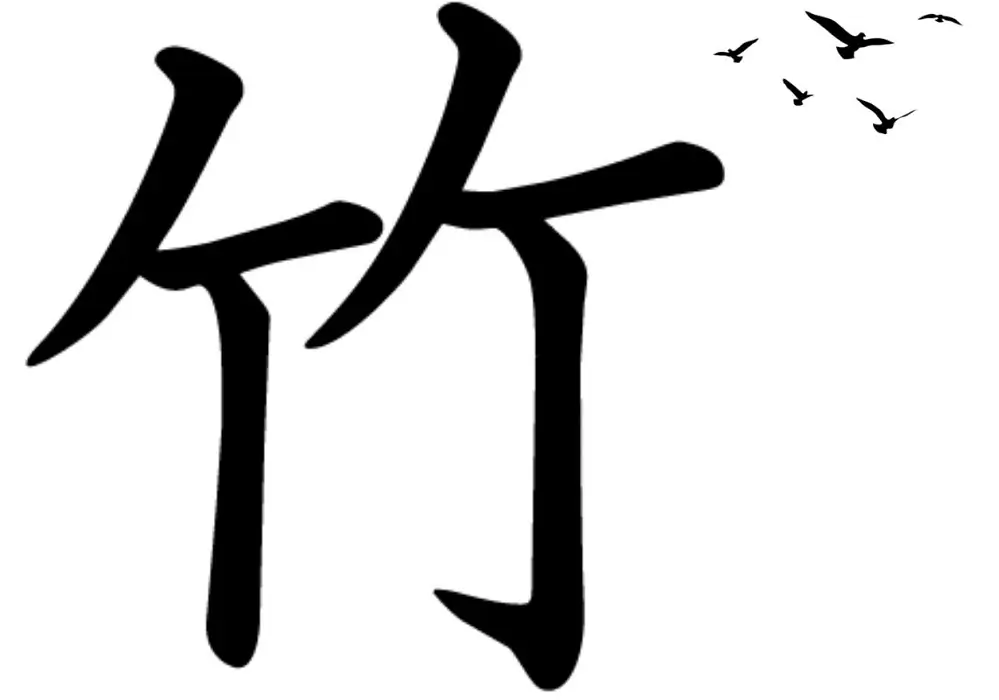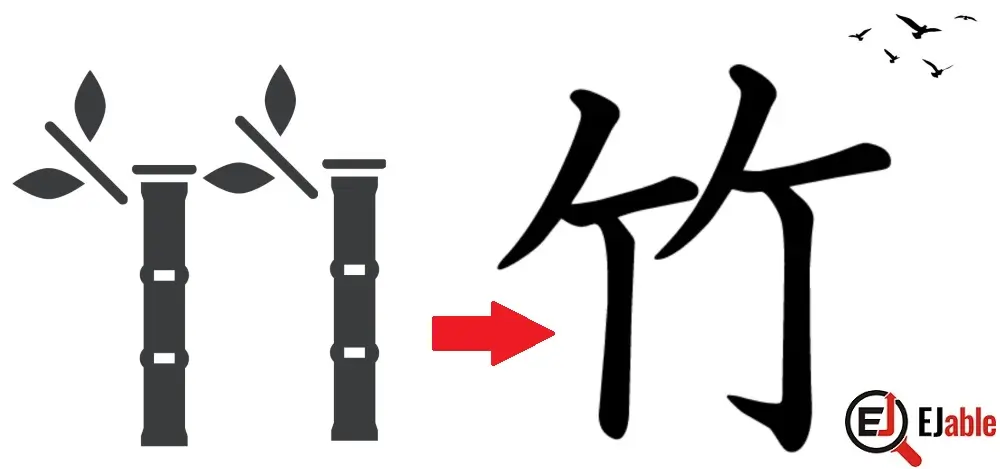Kanji for Bamboo: 竹 (Tāke)

The Japanese kanji for “bamboo” is 竹. The Kunyomi or the Japanese pronunciation of the Kanji 竹 is “tāke” (たけ), and the Onyomi (Chinese) pronunciation is “chiku” (チク).
Bamboo’s Kanji 竹 is part of JLPT N2 and is taught in grade 1 in Japanese schools.
Construction and Origin of the Shape 竹
Bamboo’s kanji 竹 is derived from a pictogram representing bamboo stalks. In its ancient form, the character resembled the actual plant more closely, representing bamboo’s distinctive segments and branches. This Kanji showing two bamboos is constructed with 6 strokes.
Over time, this pictogram evolved into the more stylized and abstract form used in modern Japanese.
Mnemonic: How to Remember the Kanji 竹 for Bamboo
As mentioned above, imagining bamboo stalks can make remembering this Kanji easy. However, the following picture will serve as a mnemonic for memorizing bamboo’s kanji quickly.


Explanation for Above Mnemonic
The vertical lines in the character mimic the tall, straight growth of bamboo, while the horizontal marks represent the segmented nature of bamboo stalks.
Other Meanings of the Kanji 竹:
While the primary meaning of 竹 is “bamboo,” the kanji can also be seen as a symbol of strength and flexibility. Bamboo is known for its rapid growth and resilience, qualities that are often admired and symbolized by the kanji 竹 in various contexts.
In addition, 竹 is used as a radical in other kanji characters, often to impart meanings related to bamboo or, by extension, concepts associated with the qualities of bamboo. For instance, 箸 (はし, hashi), which means “chopsticks,” uses 竹 as a radical, reflecting the common use of bamboo in making chopsticks.
The kanji 竹 is thus a vivid representation of bamboo, capturing its distinctive physical characteristics and the qualities it symbolizes.
Cultural Context of Bamboo’s Kanji
The way bamboo sways in the wind but doesn’t break symbolizes graceful endurance in adversity.
Bamboo represents strength, flexibility, and rapid growth, and in Japanese culture, it is respected for these unique qualities. Traditionally, Japanese society related these characteristics with resilience, adaptability, and purity. And that still holds true.
竹 as a Radical and Component in other Kanji Characters
the kanji for “bamboo,” 竹 (tāke), is also commonly used as a Kanji radical in the Japanese writing system. When used as a radical, it’s known as “たけかんむり” (takekanmuri) and is typically found at the top of the kanji. It often imparts meanings related to bamboo or qualities associated with bamboo, such as flexibility, straightness, or rapid growth.
Please note that the radical of Bamboo’s Kanji does not appear in its full form, i.e., as 竹 but as a radical, this kanji takes the shape of ⺮.
Examples of 竹 as a radical
Following are some examples of kanji where 竹 (bamboo) appears as a radical:
- 笛 (ふえ, fue): Flute.
- 筆 (ふで, fude): Brush, writing brush.
- 等 (とう, tou): Class, grade, equal; suffix for names.
- 算 (さん, san): Calculate, count.
- 策 (さく, saku): Scheme, plan.
- 節 (せつ, setsu): Node, section.
- 箱 (はこ, hako): Box.
- 筋 (すじ, suji): Muscle, string, line.
- 築 (ちく, chiku): Construct, build.
- 範 (はん, han): Example, model.
- 箸 (はし, hashi): Chopsticks.
- 筒 (とう, tou): Cylinder, pipe.
- 箇 (か, ko): Counter for items.
- 箋 (せん, sen): Paper, label.
- 篭 (かご, kago): Basket, cage.
These examples illustrate how the bamboo radical conveys various meanings, often related to objects traditionally made from bamboo or concepts associated with bamboo.
Bamboo (竹) Kanji in Compounded Words
While 竹 denotes “Bamboo,” its use extends to various compound words and expressions describing either objects made of bamboo or having bamboo’s qualities. There are 71 Japanese words that begin with the Kanji 竹, and it appears in 123 words.
Examples of Kanji 竹 in Compounded Kanji Characters
Following are the examples where Kanji for bamboo appears in Japanese compounded Kanji characters:
- 竹林 (ちくりん, chikurin): Bamboo Forest.
- 竹製 (たけせい, takesei): Made of bamboo.
- 竹馬 (たけうま, takeuma): Stilts (literally “bamboo horse”).
- 竹刀 (しんあい, shinai): Bamboo sword used in Kendo.
- 竹材 (たけざい, takezai): Bamboo material.
- 竹細工 (たけざいく, takezaiku): Bamboo craft.
- 竹筒 (たけづつ, takedzutsu): Bamboo tube/cylinder.
- 竹炭 (たけずみ, takezumi): Bamboo charcoal.
- 竹の子 (たけのこ, takenoko): Bamboo shoot.
- 竹輪 (ちくわ, chikuwa): A type of processed seafood product shaped like a bamboo ring.
- 竹林院 (ちくりんいん, Chikurin-in): Name of a place or a historical building.
- 竹刀剣 (しんあいけん, shinai ken): Another term for a bamboo sword.
- 竹籠 (たけかご, takekago): Bamboo basket.
- 竹垣 (たけがき, takegaki): Bamboo fence.
- 竹彫 (たけぼり, takebori): Bamboo carving.
These compound words demonstrate bamboo’s versatility and cultural significance in Japanese culture, ranging from physical objects made of bamboo that reflect bamboo’s qualities.
Check other Kanji characters on the page “How to Remember Kanji“. You may also like to read about the common Kanji radicals.


A long-term ex-pat in Japan, Himanshu comes with an IT background in SAP consulting, IT Business Development, and then running the country operations of an IT consulting multinational. Himanshu is the co-founder and Managing Director of ReachExt K.K. and EJable.com. He is also an Advisory Board Member of a Silicon Valley AI/IoT startup.

